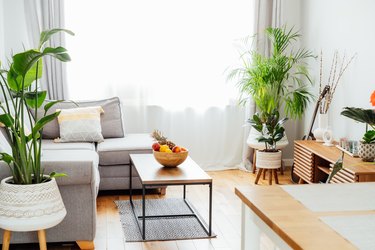
The benefits of having indoor plants are well established. Flowering and nonflowering plants can liven up and enhance the appearance of a space and improve your mood and sense of well-being. However, there are also drawbacks to keeping plants inside your home. Disadvantages of indoor plants include maintenance requirements, pests and in some cases, toxicity.
Disadvantages of Indoor Plants
Video of the Day
While aesthetics are the primary benefit of indoor plants, one of their main drawbacks is that they require maintenance during the growing season, such as proper watering and feeding, in order to look their best. Some plants require more maintenance than others and have different cultural needs, so it is important to choose plants suitable for the amount of light and humidity in your home environment.
Video of the Day
Plants that do not receive adequate light or moisture may wilt and drop their leaves. That means after a vacation, you may come home to find your indoor plants looking a bit weak unless you find someone to look after your plants while you are away.
Like any other object in the house, indoor plants can collect dust and therefore may need to be wiped down regularly. Indoor plants may also outgrow their containers, which means that you will have to take the time to repot them periodically. It may also be necessary to prune indoor plants occasionally.
Indoor Plant Pests
Indoor plants that are not properly cared for are prone to becoming infested with pests. Several pests are common on indoor plants, including spider mites, aphids, mealybugs and scale. Spider mites, which are related to arachnids rather than other insects, are hard to see with the naked eye but create visible webs. Aphids, mealybugs and scale insects are small insects that secrete a sticky substance known as honeydew that attracts black sooty mold.
Because they feed on plant sap, all of these pests can result in yellowing of leaves, leaf drop and in severe cases, stunted plant growth. The best way to avoid these infestations is to make sure to give your indoor plants sufficient moisture, light and fertilizer and ensure that the containers drain well. To prevent infestations, you also want to avoid using soil from your garden for indoor plants and purchase only nursery plants that look healthy. If a houseplant becomes severely infested, it may need to be discarded.
Indoor Plants and Pets
If you have dogs or cats, you'll want to be mindful of which plants you bring into your home, as many popular indoor plants are toxic to pets. Examples of toxic plants include lilies (Lilium spp.,), a common Easter-time flowering plant that contains compounds that can cause kidney damage in cats, even in small amounts.
The succulent species known as kalanchoe (Kalanchoe spp.) can have adverse cardiac effects in animals. The sago palm (Cycas revoluta) is considered severely toxic and can cause liver failure if consumed. Reach out to a poison control center or your veterinarian right away if your dog or cat has eaten a toxic plant.
Plants that are nontoxic to pets and therefore safe to have around the house include African violets (Streptocarpus spp.) and the spider plant (Chlorophytum comosum). The latter is a great option for hanging baskets, which can help to keep plants out of reach of pets.
- University of Minnesota Extension: Managing Insects on Indoor Plants
- Clemson Cooperative Extension: Common Houseplant Insects & Related Pests
- ASPCA Pro: 17 Plants Poisonous to Pets
- Humane Society of North Texas: 11 Pet Friendly Houseplants
- ASPCA: Is That Houseplant Safe for Your Pets?
- University of Florida IFAS Extension: Caring for Houseplants
- PennState Extension: The Argument for Houseplants